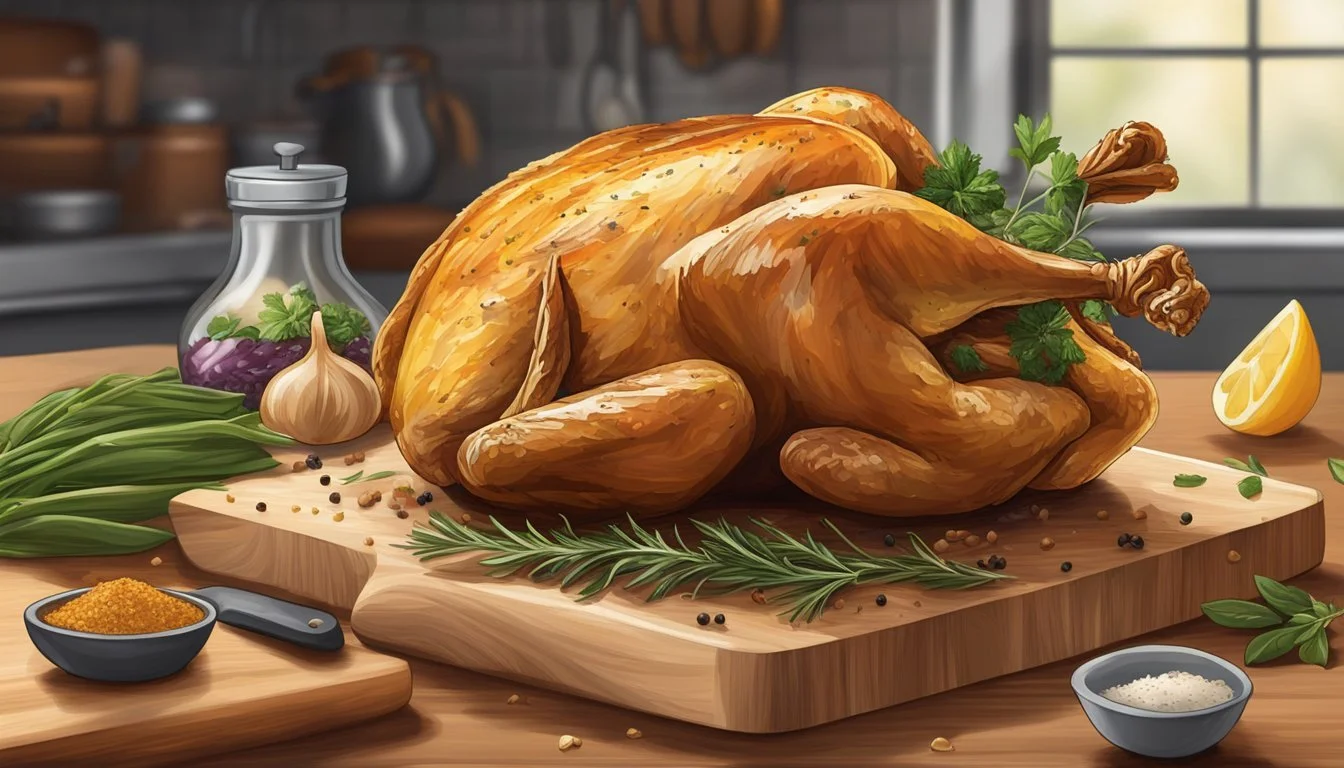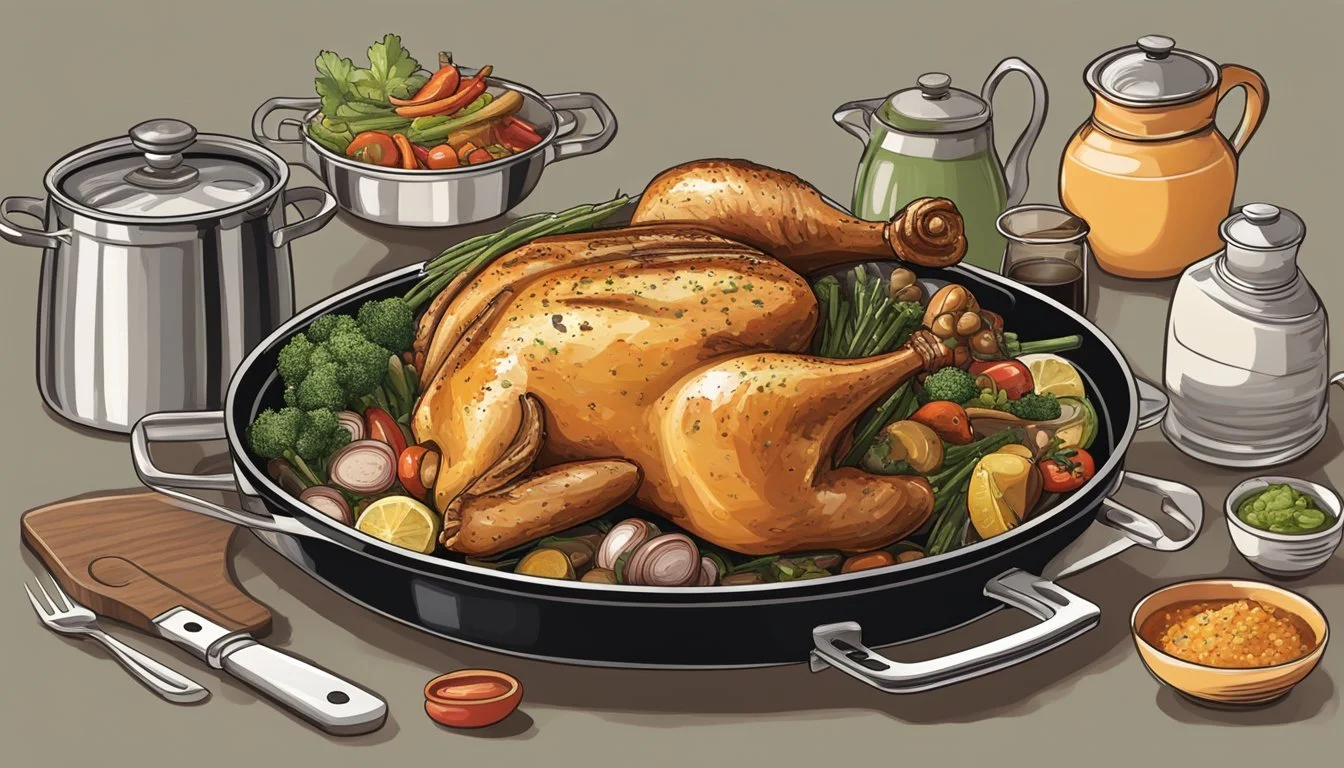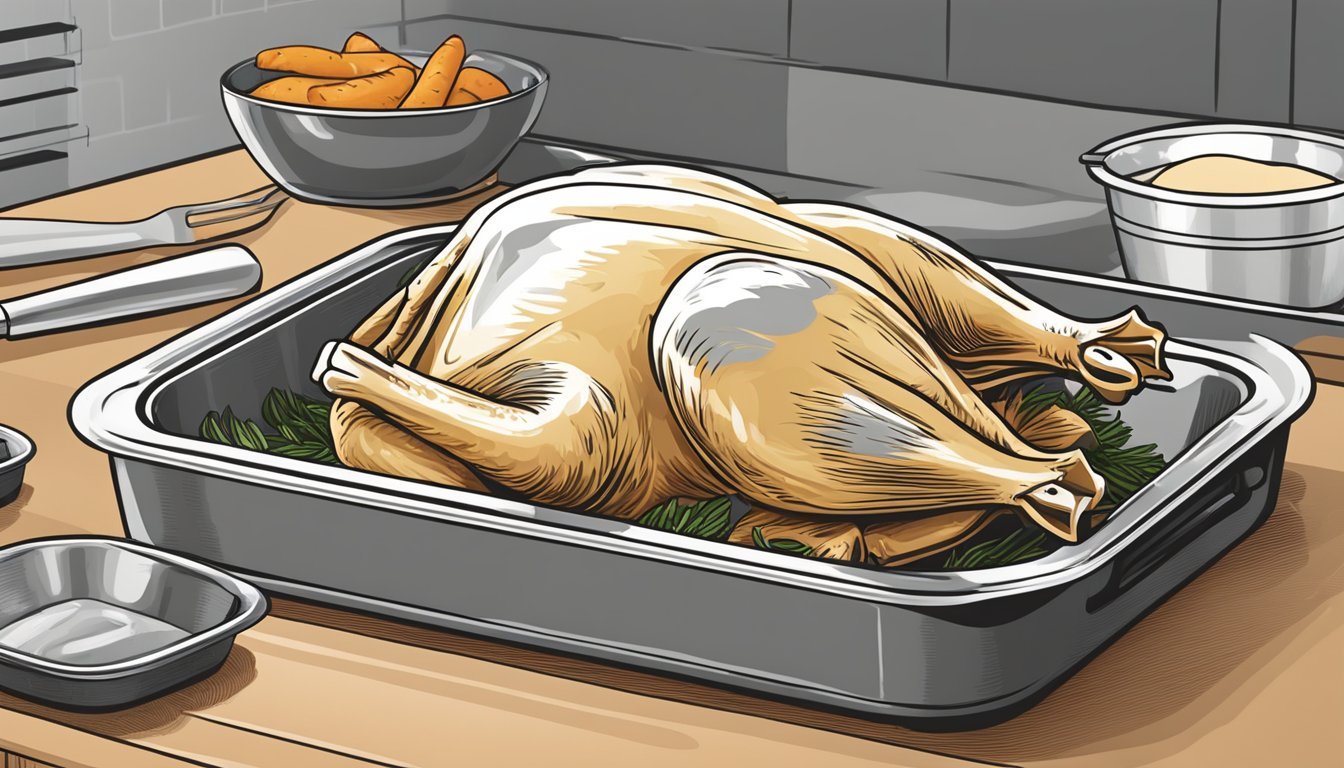How to Perfectly Roast a 5.5 lb Chicken
Tender and Juicy Results
Cooking a 5.5 lb chicken can be a delightful culinary adventure, perfect for a family dinner or special occasion. This versatile bird offers endless possibilities for flavors and preparation methods. To achieve perfectly roasted chicken, preheat the oven to 425°F and cook for approximately 1 hour and 15 minutes, or until the internal temperature reaches 160°F.
Preparing a whole chicken allows for a stunning presentation and ensures juicy, flavorful meat throughout. The process begins with removing giblets, patting the bird dry, and seasoning it generously. Many cooks opt to tuck herbs and aromatics into the cavity for added depth of flavor. Placing the chicken in a roasting pan and trussing the legs can help promote even cooking and maintain the bird's shape.
Essential Cooking Tools and Preparations
Preparing a 5.5 lb chicken requires specific equipment and careful setup. The right tools and proper oven preparation ensure a delicious, evenly cooked bird.
Choosing the Right Roasting Pan
A sturdy roasting pan is crucial for cooking a 5.5 lb chicken. Opt for a heavy-duty pan with low sides to promote air circulation. Stainless steel or aluminum pans work well, distributing heat evenly.
Choose a pan large enough to accommodate the chicken without overcrowding. A 16x13 inch roasting pan is typically suitable for a 5.5 lb bird.
Consider a pan with a removable rack. This elevates the chicken, allowing heat to circulate underneath and promoting crispy skin all around.
Must-Have Kitchen Tools
A reliable meat thermometer is essential for ensuring your chicken reaches the safe internal temperature of 165°F (74°C). An instant-read thermometer provides quick, accurate readings.
Kitchen twine helps truss the chicken, keeping its shape during cooking. This promotes even cooking and a more attractive presentation.
Heavy-duty aluminum foil is useful for tenting the chicken if it browns too quickly.
Sharp kitchen shears make removing the backbone easier if you prefer to spatchcock the chicken for faster cooking.
Preheating the Oven
Proper preheating is crucial for even cooking. Set your oven to 375°F (190°C) and allow it to fully preheat before inserting the chicken.
If using a convection oven, reduce the temperature by 25°F (14°C) to account for the increased efficiency of heat circulation.
Ensure your oven racks are positioned correctly. For a whole chicken, place the rack in the lower third of the oven to allow enough space for the roasting pan.
Clean your oven before cooking to prevent any off-flavors from affecting your chicken.
Preparing the Chicken
Proper preparation is crucial for a delicious roast chicken. This process involves cleaning, drying, seasoning, and trussing the bird to ensure even cooking and maximum flavor.
Cleaning and Drying
Remove the giblets from the chicken's cavity. These can be saved for making gravy or discarded. Rinse the chicken inside and out under cold running water.
Pat the chicken dry thoroughly with paper towels. This step is essential for achieving crispy skin during roasting.
Sprinkle kosher salt and black pepper generously over the entire surface of the chicken, including inside the cavity. This seasons the meat and helps draw out moisture.
Stuffing the Cavity
Aromatics enhance the flavor of the chicken from the inside out. Common choices include:
Halved lemons
Garlic cloves (whole or crushed)
Fresh herbs like thyme, rosemary, or sage
Quartered onions
Gently stuff these ingredients into the cavity. Don't overfill, as this can affect cooking time and temperature.
For added richness, rub softened butter under the skin of the breast and thighs. This keeps the meat moist and adds flavor.
Trussing the Chicken
Trussing helps the chicken cook evenly and maintain its shape. Here's a simple method:
Cut a piece of kitchen twine about 3 feet long.
Center the twine under the chicken's tail.
Bring the ends up and over the legs, crossing them.
Pull tight to bring the legs together.
Wrap the string around the legs and tie a knot.
Bring the string up to the wings, tucking them in.
Tie the string at the neck to secure everything.
This process keeps the wings and legs close to the body, promoting even cooking and a beautiful presentation.
Seasoning for Perfection
A well-seasoned chicken elevates the roasting experience. The right blend of herbs and spices enhances flavor and creates a delicious crust.
Creating the Seasoning Mix
Start with a base of salt and black pepper. Add garlic powder for depth and paprika for a subtle smoky flavor. Dried rosemary brings an aromatic touch. Mix these ingredients in a small bowl.
For a 5.5 lb chicken, use:
2 tablespoons salt
1 tablespoon black pepper
2 teaspoons garlic powder
2 teaspoons paprika
1 teaspoon dried rosemary
Adjust quantities to taste. Fresh herbs can replace dried ones, but use 3 times the amount. For added zest, include lemon zest or dried thyme.
Applying the Seasoning
Pat the chicken dry with paper towels. This step ensures the seasoning adheres properly. Drizzle olive oil over the entire surface of the bird.
Sprinkle the seasoning mix evenly over the chicken, including the cavity. Gently massage it into the skin. For extra flavor, carefully loosen the skin and rub some seasoning directly onto the meat.
Fresh garlic cloves, crushed and mixed with olive oil, can be rubbed under the skin for intense flavor. Place lemon wedges or fresh rosemary sprigs in the cavity for aromatic results.
Let the seasoned chicken rest for 30 minutes before roasting. This allows the flavors to penetrate the meat.
Cooking the Chicken
Properly cooking a 5.5 lb chicken requires attention to oven temperature, roasting time, and determining doneness. These factors ensure a perfectly cooked bird with juicy meat and crispy skin.
Understanding Oven Temperatures
For a 5.5 lb chicken, preheat the oven to 425°F (218°C). This high temperature promotes crispy skin and faster cooking. Some recipes suggest a lower temperature of 375°F (190°C) for a slower roast.
Convection ovens circulate hot air, reducing cooking time. Set a convection oven to 325°F (165°C) for even browning and moist meat.
Place the chicken on a rack in a roasting pan. This allows air to circulate, cooking the bird evenly.
Roasting Time and Techniques
A 5.5 lb chicken typically takes 1 hour and 15 minutes to 1 hour and 30 minutes to roast at 425°F.
Start by patting the chicken dry with paper towels. This step helps achieve crispy skin.
Rub the skin with olive oil or butter, and season generously with salt and pepper.
For added flavor, stuff the cavity with lemon wedges, garlic cloves, and fresh herbs.
Some cooks prefer to baste the chicken every 20-30 minutes with pan juices or melted butter. This can enhance flavor but may extend cooking time.
Testing for Doneness
Use a meat thermometer to ensure the chicken is fully cooked. Insert it into the thickest part of the thigh, avoiding bone.
The internal temperature should reach 165°F (74°C) for safe consumption.
Check multiple areas, including the breast, to ensure even cooking.
If the skin browns too quickly, loosely cover the chicken with foil.
Let the chicken rest for 10-15 minutes after removing from the oven. This allows juices to redistribute, resulting in moister meat.
Carve and serve the chicken immediately after resting for the best flavor and texture.
After Cooking Care
Proper care after cooking a 5.5 lb chicken is crucial for optimal flavor and texture. Resting and carving techniques ensure juicy meat and an enjoyable dining experience.
Resting the Chicken
Let the cooked chicken rest for 10-15 minutes after removing it from the oven. This allows the juices to redistribute throughout the meat, resulting in a more tender and flavorful dish.
Place the chicken on a cutting board and loosely tent it with aluminum foil. The internal temperature will continue to rise slightly during this time, completing the cooking process.
Resting prevents the juices from immediately escaping when the chicken is cut, keeping the meat moist and succulent.
Carving and Serving
After resting, it's time to carve the chicken. Start by removing the legs and thighs, then separate the wings from the body.
Slice the breast meat against the grain for tender pieces. Use a sharp knife to ensure clean cuts and preserve the meat's texture.
Arrange the carved chicken on a serving platter, garnishing with fresh herbs if desired. Serve immediately to enjoy the chicken at its best temperature and texture.
Consider pairing the roasted chicken with complementary side dishes such as roasted vegetables or a crisp salad to complete the meal.
Sides and Accompaniments
Choosing the right sides and accompaniments enhances the overall meal experience when serving a roasted 5.5 lb chicken. Thoughtful selection and preparation of vegetables and other side dishes complement the main course perfectly.
Selecting Vegetables and Sides
Roasted vegetables pair excellently with chicken. Carrots, onions, and potatoes are classic choices. Cut them into uniform sizes for even cooking. Brussels sprouts, bell peppers, and zucchini also work well.
For starchy sides, consider roasted or mashed potatoes. Rice and pasta offer versatile alternatives. Prepare a simple pilaf or buttered noodles to soak up the chicken's juices.
Fresh salads provide a crisp contrast. Mix leafy greens with cherry tomatoes, cucumber, and a light vinaigrette. Coleslaw or a broccoli salad can add crunch and color to the plate.
Preparation Tips for Accompaniments
Timing is crucial when preparing sides. Start roasting hardy vegetables like potatoes and carrots alongside the chicken. Add quicker-cooking veggies later to prevent overcooking.
Season vegetables with herbs that complement the chicken's flavors. Rosemary, thyme, and garlic work well. Toss veggies in olive oil before roasting for better browning.
For mashed potatoes, use warm milk and butter for a creamy texture. Prepare rice or pasta just before serving to maintain ideal consistency. Dress salads at the last minute to keep greens crisp.
Consider making a pan gravy from the chicken drippings. This sauce ties the entire meal together, enhancing both the meat and sides.
Utilizing Leftovers
Leftover roasted chicken offers versatile options for quick and delicious meals. Proper storage ensures food safety and maintains quality, while creative recipes transform leftovers into entirely new dishes.
Storage and Preservation
Store leftover chicken in airtight containers in the refrigerator within two hours of cooking. Properly stored, cooked chicken stays fresh for 3-4 days. For longer storage, freeze chicken in freezer-safe bags or containers for up to 4 months.
Remove bones before freezing to save space. Label containers with the date to track freshness. When reheating, ensure chicken reaches 165°F (74°C) internal temperature.
Refrigerated chicken can be eaten cold or gently reheated in the microwave, oven, or skillet. Add a splash of water or broth to prevent drying.
Innovative Leftover Ideas
Transform leftover chicken into new meals. Shred for chicken salad, mix with mayo, celery, and seasonings. Use in sandwiches, wraps, or atop salads.
Dice chicken for quesadillas with cheese and vegetables. Add to soups or pasta dishes for protein. Make chicken fried rice or stir-fry with vegetables.
Use bones to make homemade chicken broth. Simmer with vegetables and herbs for a flavorful base for soups or homemade gravy.
Create quick weeknight dinners by adding leftover chicken to casseroles, pizza, or stuffed peppers. Mix into macaroni and cheese for a heartier meal.
Final Tips and Tricks
Mastering the art of cooking a 5.5 lb chicken requires attention to detail and a few key techniques. These tips will help elevate your roast chicken from good to exceptional.
Achieving the Best Flavor
Brine the chicken for 4-6 hours before cooking to enhance moisture and flavor. Mix 1/4 cup salt and 1/4 cup sugar in 4 cups of water. Submerge the chicken fully in the brine, refrigerating until ready to cook.
Pat the chicken dry thoroughly before seasoning. This step ensures crispy skin. Rub softened butter under the skin for extra richness and flavor.
Season liberally with salt, pepper, and herbs like thyme and rosemary. For a classic flavor profile, stuff the cavity with lemon halves, garlic cloves, and fresh herbs.
Let the chicken rest at room temperature for 30 minutes before roasting. This promotes even cooking.
Troubleshooting Common Issues
Undercooked chicken: Use a meat thermometer to check doneness. Insert it into the thickest part of the thigh, avoiding bone. The internal temperature should reach 165°F (74°C).
Dry meat: Avoid overcooking. Start checking for doneness 15 minutes before the estimated cooking time. Baste the chicken every 20-30 minutes with pan juices or melted butter.
Uneven browning: Truss the chicken legs and tuck the wings under the body. This creates a compact shape for even cooking. Rotate the pan halfway through cooking if needed.
Soggy skin: Cook the chicken on a rack in the roasting pan. This allows air to circulate, resulting in crispier skin all around.










